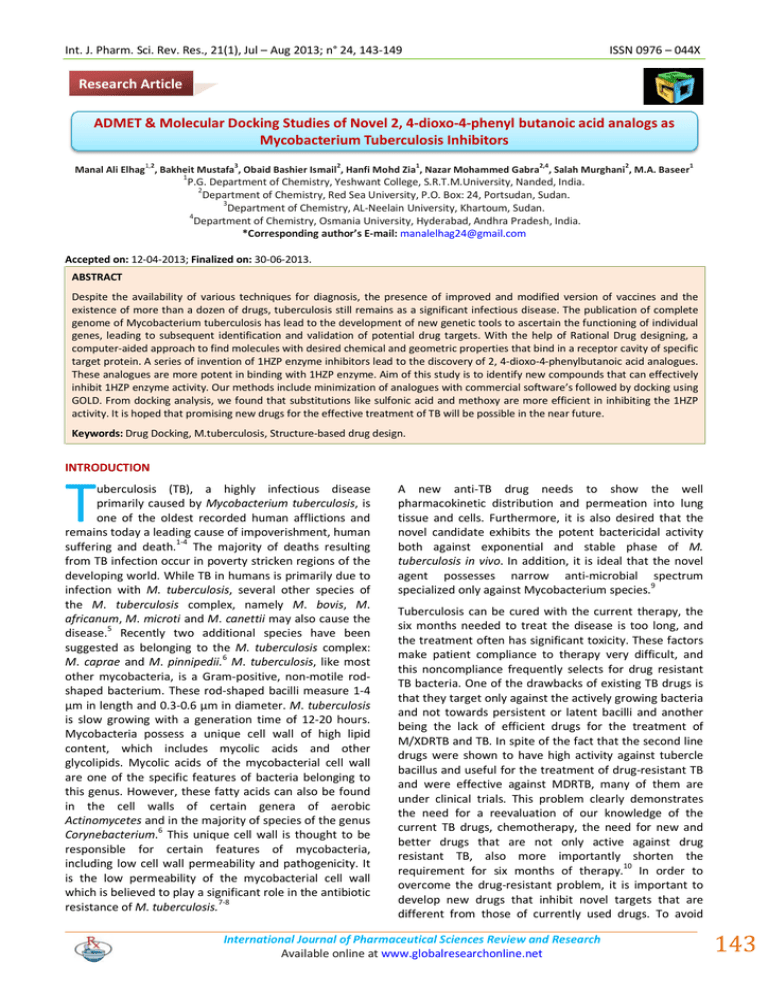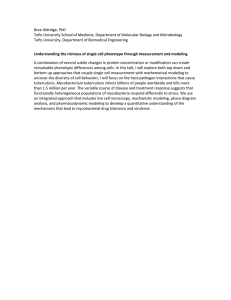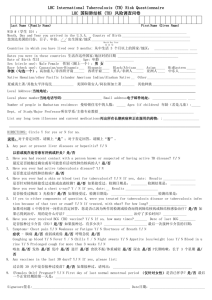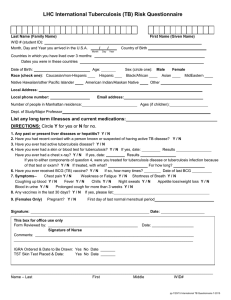Document 13309160
advertisement

Int. J. Pharm. Sci. Rev. Res., 21(1), Jul – Aug 2013; n° 24, 143-149 ISSN 0976 – 044X Research Article ADMET & Molecular Docking Studies of Novel 2, 4-dioxo-4-phenyl butanoic acid analogs as Mycobacterium Tuberculosis Inhibitors Manal Ali Elhag1,2, Bakheit Mustafa3, Obaid Bashier Ismail2, Hanfi Mohd Zia1, Nazar Mohammed Gabra2,4, Salah Murghani2, M.A. Baseer1 1 P.G. Department of Chemistry, Yeshwant College, S.R.T.M.University, Nanded, India. 2 Department of Chemistry, Red Sea University, P.O. Box: 24, Portsudan, Sudan. 3 Department of Chemistry, AL-Neelain University, Khartoum, Sudan. 4 Department of Chemistry, Osmania University, Hyderabad, Andhra Pradesh, India. *Corresponding author’s E-mail: manalelhag24@gmail.com Accepted on: 12-04-2013; Finalized on: 30-06-2013. ABSTRACT Despite the availability of various techniques for diagnosis, the presence of improved and modified version of vaccines and the existence of more than a dozen of drugs, tuberculosis still remains as a significant infectious disease. The publication of complete genome of Mycobacterium tuberculosis has lead to the development of new genetic tools to ascertain the functioning of individual genes, leading to subsequent identification and validation of potential drug targets. With the help of Rational Drug designing, a computer-aided approach to find molecules with desired chemical and geometric properties that bind in a receptor cavity of specific target protein. A series of invention of 1HZP enzyme inhibitors lead to the discovery of 2, 4-dioxo-4-phenylbutanoic acid analogues. These analogues are more potent in binding with 1HZP enzyme. Aim of this study is to identify new compounds that can effectively inhibit 1HZP enzyme activity. Our methods include minimization of analogues with commercial software’s followed by docking using GOLD. From docking analysis, we found that substitutions like sulfonic acid and methoxy are more efficient in inhibiting the 1HZP activity. It is hoped that promising new drugs for the effective treatment of TB will be possible in the near future. Keywords: Drug Docking, M.tuberculosis, Structure-based drug design. INTRODUCTION T uberculosis (TB), a highly infectious disease primarily caused by Mycobacterium tuberculosis, is one of the oldest recorded human afflictions and remains today a leading cause of impoverishment, human suffering and death.1-4 The majority of deaths resulting from TB infection occur in poverty stricken regions of the developing world. While TB in humans is primarily due to infection with M. tuberculosis, several other species of the M. tuberculosis complex, namely M. bovis, M. africanum, M. microti and M. canettii may also cause the disease.5 Recently two additional species have been suggested as belonging to the M. tuberculosis complex: M. caprae and M. pinnipedii.6 M. tuberculosis, like most other mycobacteria, is a Gram-positive, non-motile rodshaped bacterium. These rod-shaped bacilli measure 1-4 µm in length and 0.3-0.6 µm in diameter. M. tuberculosis is slow growing with a generation time of 12-20 hours. Mycobacteria possess a unique cell wall of high lipid content, which includes mycolic acids and other glycolipids. Mycolic acids of the mycobacterial cell wall are one of the specific features of bacteria belonging to this genus. However, these fatty acids can also be found in the cell walls of certain genera of aerobic Actinomycetes and in the majority of species of the genus 6 Corynebacterium. This unique cell wall is thought to be responsible for certain features of mycobacteria, including low cell wall permeability and pathogenicity. It is the low permeability of the mycobacterial cell wall which is believed to play a significant role in the antibiotic resistance of M. tuberculosis.7-8 A new anti-TB drug needs to show the well pharmacokinetic distribution and permeation into lung tissue and cells. Furthermore, it is also desired that the novel candidate exhibits the potent bactericidal activity both against exponential and stable phase of M. tuberculosis in vivo. In addition, it is ideal that the novel agent possesses narrow anti-microbial spectrum specialized only against Mycobacterium species.9 Tuberculosis can be cured with the current therapy, the six months needed to treat the disease is too long, and the treatment often has significant toxicity. These factors make patient compliance to therapy very difficult, and this noncompliance frequently selects for drug resistant TB bacteria. One of the drawbacks of existing TB drugs is that they target only against the actively growing bacteria and not towards persistent or latent bacilli and another being the lack of efficient drugs for the treatment of M/XDRTB and TB. In spite of the fact that the second line drugs were shown to have high activity against tubercle bacillus and useful for the treatment of drug-resistant TB and were effective against MDRTB, many of them are under clinical trials. This problem clearly demonstrates the need for a reevaluation of our knowledge of the current TB drugs, chemotherapy, the need for new and better drugs that are not only active against drug resistant TB, also more importantly shorten the 10 requirement for six months of therapy. In order to overcome the drug-resistant problem, it is important to develop new drugs that inhibit novel targets that are different from those of currently used drugs. To avoid International Journal of Pharmaceutical Sciences Review and Research Available online at www.globalresearchonline.net 143 Int. J. Pharm. Sci. Rev. Res., 21(1), Jul – Aug 2013; n° 24, 143-149 significant toxicity, the targets of inhibition should be present in bacteria but not in the human host. Although modification of existing drugs for improved half-life, bioavailability, or drug delivery may be of some use, agents obtained by this approach may have a crossresistance problem, as seen in the new rifamycins or quinolones. Similarly, targeting existing TB drug targets for drug development may be of limited value because of potential cross resistance. New drugs that inhibit novel targets are needed. Hence, there is a desperate need for better drugs against M/XDR, HIV and persistent TB.11 This brief review provides useful information regarding computer based drug designing strategies in TB. This is the important area where progress for TB is still at its infancy, unlike other diseases there are very few drugs designed using rational drug design in the field of TB. Hopefully drugs designed using these strategies will be used to develop drugs for treatment of TB in future, more ISSN 0976 – 044X particularly will provide solution to the currently facing problem of drug resistance. History of Anti tuberculosis Drugs The TB drugs in use today reflect their origins in two sources of antimicrobial agents, i.e., chemical origin and antibiotic origin. Albert Schatz and Selman Waksman discovered the first effective TB drug streptomycin (Figure 1) from Streptomyces griseus in 1944 12, a discovery that marked the beginning of modern TB chemotherapy. The modern chemotherapeutic treatment of TB also had its beginning in sulfa drugs developed by Domagk for the treatment of gram-positive bacteria infections.13 In 1938, Rich and Follis from Johns Hopkins University found that sulfanilamide at high doses significantly inhibited the disease pathology in experimental TB infection in guinea 14 pigs but without significant effect in treatment of human TB in tolerable doses. Figure 1: Structures of some commonly used TB drugs. Computer-aided drug design (CADD) Computer-aided drug design, often called structure based design involves using the biochemical information of ligand-receptor interaction in order to postulate ligand refinements i.e. improvement in binding affinity to receptor. Identification of new lead compounds for new target depends on the information of the target-ligand system, like target and ligand are well known or Target is known but ligand is not known, or ligand is known etc. A large no. of software’s is available on different information and different strategy for new lead compounds, like Ligbuilder, ACD lab and ligand scout 2.0. Compatibility of target and ligand could be performed through docking. Docking is a method which predicts the preferred orientation of target to ligand when bound to each other to form a stable complex. Molecular-docking- based virtual screening is an important tool in drug discovery that is used to significantly reduce the number of possible chemical compounds to be investigated. In addition to the selection of a sound docking strategy with appropriate scoring functions, another technical challenge is to in silico screen millions of compounds in a reasonable time. To meet this challenge, it is necessary to use high performance computing (HPC) platforms and techniques. Several commercial as well as Academics are available.15 MATERIALS AND METHODS Ligand & Protein Selection Enzyme mtFabH, a homodimer (PDB: 1HZP) was retrieved from the RSCB PDB website (http://www.pdb.org) with PDB ID: 1HZP Selected target were structurally International Journal of Pharmaceutical Sciences Review and Research Available online at www.globalresearchonline.net 144 Int. J. Pharm. Sci. Rev. Res., 21(1), Jul – Aug 2013; n° 24, 143-149 characterized (Active site) through online tools (Pocket finder, p-cats or Pose View (www.poseview.de/poseview/wizard)). Figure 2 show Active binding sites of enzyme mtFabH (PDB ID: 1HZP). And also verified by using graphic interface of Accelry’s Discovery Studio 3.5. Analogs of 2, 4-dioxo-4phenylbutanoic acid inhibitor were drawn by selecting 2, 4-dioxo-4-phenylbutanoic acid as Lead moiety and altering its hydroxyl groups using chem. Draw Ultra 9.0 according to the Lipinski’s rule. 2, 4-dioxo-4phenylbutanoic acid analogs and modified structures were listed in Figure 2. ISSN 0976 – 044X 2b 3b 1c Active site Identification Active site of enzyme mtFabH, a homodimer (PDB: 1HZP) was identified using CASTP server.16 A new program, CAST, for automatically locating and measuring protein binding pockets and cavities, is based on precise computational geometry methods, including alpha shape and discrete flow theory. CAST identifies and measures pockets and pocket mouth openings, as well as cavities. The program specifies the atoms lining pockets, pocket openings, and buried cavities; the volume and area of pockets and cavities; and the area and circumference of mouth openings. When the search is complete, the largest site is automatically displayed on the structure. The results can be used to guide the protein–ligand docking experiment. Molecule code 1a 2a Structures of designed compounds 2c Figure 2: Structures of designed compounds Virtual screening Molecular-docking-based virtual screening is an important tool in drug discovery that is used to significantly reduce the number of possible chemical compounds to be investigated. Screenings of best compatible ligand to target were performed through docking.17 ADME & Toxicity Profiles For all the newly designed ligands, ADME properties were studied by using online server ADME SAR.com which we predicted the levels for Blood-Brain-Barrier (BBB) penetration18, Intestinal Absorption19, Aq. Solubility20, Hepatotoxicity21 and Plasma Protein Binding (PPB) levels.22 Docking simulations 3a 4a 5a 1b Molecular docking of designed compounds into the three dimensional X-ray structure of (PDB: 1HZP) enzyme was carried out using the GOLD (Genetic Optimization for Ligand Docking) software package (version 3.0.1) as implemented through the graphical user interface Silver Descriptor 1.1. The Silver Descriptor interface program was used to generate the docking input files. Ten runs were generated by using genetic algorithm searches. Automatic settings were used and the results differing within 1.5 Å in positional root–mean– square deviation (RMSD) were clustered together and the results of the most favorable free energy of binding were selected as the resultant complex structures. RESULTS AND DISCUSSION Computer-assisted drug design (CADD) approach has contributed to the successful discovery of several novels anti tuberculosis agents. Molecular Docking continues to International Journal of Pharmaceutical Sciences Review and Research Available online at www.globalresearchonline.net 145 Int. J. Pharm. Sci. Rev. Res., 21(1), Jul – Aug 2013; n° 24, 143-149 hold great promise in the field of computer based drug design which screens small molecules by orienting and scoring them in the binding site of a protein. Number of reports citing successful application of CADD in developing specific drugs in different therapeutic areas is expanding rapidly. There are various tools, which can be used for Computer aided drug design such as QSAR, Docking, Homology modeling, ADMET prediction etc. ADME Sar.com pharmacokinetic prediction and protocols of ACD/LAB. Provides us physicochemical properties with it BBB and % oral absorption predictions .These all parameters are helpful to find out bioavailability and 23 toxicity prediction in human body. The initial focus of ISSN 0976 – 044X our ligand design was based on the active site geometry and mechanism of action of the target enzyme mtFabH, a homodimer (PDB: 1HZP) retrieved from PDB website is geometrically optimized and screened for its active binding sites. 2, 4-dioxo-4-phenylbutanoic acid analogs were designed according to Lipinski’s Rule of Five and geometrically optimized to their least energy – high stability state and their molecular properties like, Molecular wt.(MW), surface area, volume, log P are listed in the Table 1. Optimized ligands are used for the ADMET studies and also for Molecular Docking studies along with the optimized protein. Table 1: Molecular properties of tuberculostatic agents Molecule code M Wt Log P H.D nrotb volume polar surface area Number of Violations Rule of 5 H.A 1a 192.17 0.146 4 4 165.814 71.441 0 1 2a 206.197 0.595 4 4 182.375 71.441 0 1 3a 272.253 -0.808 5 3 232.2 119.608 0 7 4a 207.185 -0.778 5 4 177.102 97.464 0 3 5a 208.169 -0.333 5 4 173.831 91.669 0 2 1b 210.16 0.31 4 4 170.745 71.441 0 1 2b 271.066 0.955 4 4 183.699 71.441 0 1 3b 237.167 0.105 5 5 189.148 117.265 0 7 1c 274.194 1.658 4 6 214.639 60.447 0 1 2c 272.234 -2.862 2 5 205.2 125.811 0 6 Table 2: ADME profiles of the 2, 4-dioxo-4-phenylbutanoic acid analogs Ligand NO BBB level Absorption level 1a 0.9635 0.9361 2a 0.9520 3a Solubility level Hepatotoxicity level CYP2D6 level PPB level -1.5825 1 0 0 0.9622 -1.8056 1 0 0 0.8501 0.9117 -1.6498 1 0 0 4a 0.8717 0.7831 -1.5122 1 0 0 5a 0.7802 0.8998 -1.2753 1 0 0 1b 0.9844 0.9426 -2.3436 1 0 0 2b 0.9759 0.9194 -2.9835 1 0 0 3b 0.8311 0.8068 -2.3022 1 0 0 1c 0.9929 0.9836 -2.7480 1 0 0 2c 0.9465 0.6869 -2.3528 1 0 0 Molecular Docking Protein – ligand interactions were identified by using Gold docking protocol. Using GOLD, docking studies were performed to investigate the poses for our scaffold in the mtFabH active site. 24 We observed that the hydroxyl group of a and b sets forms H bonds with the O of LYS317 and LEU6, whilst the CO (carbonyl groups) are proximal to and H-bonds with the LYS317, LEU6 and ALA66: O. This allowed us to generate a hypothetical template for the development of inhibitors of mtFabH (Figure 3) shows the binding interaction of ligand 3b with enzyme 1HZP. Further docking studies were carried out with c set of strong electron withdrawing group’s substituent’s in the 2, 4-dioxo-4-phenylbutanoic acid. In methoxy substituent there are four strong hydrogen bonds formed between the O16 and O10 with LYS317, ASN65 and LEU6. Whilst the sulfonic acid substituent having six H-bonds formed between O of carbonyl and hydroxyl groups with ALA66, LYS317, LEU5, MET317 and ARG316 amino acids. We postulated that it would be reasonable at this early stage of inhibitor design to attempt this in order to establish if ligand inhibition was at all possible before addressing selectivity in later rounds of ligand optimization. Based on this rationale, we prepared a series of 2, 4-dioxo-4phenylbutanoic acid that included the substituent’s International Journal of Pharmaceutical Sciences Review and Research Available online at www.globalresearchonline.net 146 Int. J. Pharm. Sci. Rev. Res., 21(1), Jul – Aug 2013; n° 24, 143-149 studied for evaluation against the enzyme and M. tuberculosis. From the docking result listed in Table 3 we found that 2c has gold docking score of 34.312 and six hydrogen bonds. Only fluoroform substituted analog (ligand 1c) are having ISSN 0976 – 044X lesser gold score when compared to sulfonic acid substituted analog (ligand 2c). Out of 10 analogs, 6 have better gold score. Binding site pocket of the docked protein can be visualized in the figure 4 along with ligand 3b. Table 3: Docking score and interaction energies of the ligands with the1HZP Ligand No H–Bond Donor group - Acceptor group Bond Length (Å) Vander Waals interactions Bond Length (Å) Gold score 1a O6-LYS317: O 2.455 C1 – LEU6: O 2.421 27.0749 O6 – LEU6: O 2.450 C2- LEU6: O 2.698 O13 – LEU6 :CA 2.687 C8 – LEU5: O 2.598 C10 -:MET317: O 2.622 O5 – LEU5: O 2.513 27.7089 31.9411 2a 3a 4a 5a 1b 2b 3b 1c 2c O6:ALA66: O 2.988 O13 – LYS317: O 2.735 O16 – ASN65: O 2.997 C3– LEU5: O 2.710 O16– LEU6: O 2.692 C5– LEU5: O 2.286 O16- LYS317: O 2.827 O2- MET317: O 2.392 O10- LYS317: O 2.457 C1- MET317: O 2.550 N15 – LEU6: O 3.028 C4-GLY296:CA 2.622 N15 – LEU5: O 2.548 C3-GLY296:CA 2.760 O6 – ARG316: NE 2.790 O14-GLY296:CA 2.658 O14-GLY296: O 2.386 C1– LEU6: O 2.588 O6 – LYS317: O 2.535 O6– LEU6: O 2.515 C3– LEU6: O 2.290 O15 - MET317: O 2.356 C13– LEU6: CA 2.576 O15-GLY296:N 2.723 C12– LEU5: O 2.585 C10- MET317: O 2.606 O6 – LYS317: O 2.333 O13 – LEU6 :CA 2.659 O6 – LEU6: O 2.458 C8 – LEU5: O 2.567 C11 -:MET317: O 2.585 C10 -:MET317: O 2.462 F15 -:MET317: O 2.337 O6 – LEU6: O 2.487 C9 – LEU5: O 2.459 O13 – LYS317: O 2.803 C10 – LEU5: O 2.445 O3-GLY296:N 3.024 C5– LEU5: O 2.643 O17 – ASN65: O 3.012 O3- MET317: O 2.265 O17– LEU6: O 2.723 O11- LYS317: O 3.001 O12- LYS317: O 2.826 H26 -ALA66: O 2.497 O15– LEU6: O 2.205 C5– LEU5: O 2.617 F1– ARG316: O 2.347 O18 -ALA66: O 2.885 S2– LEU5: O 2.646 O15- LYS317: O 3.022 C5– LEU5: O 2.403 O1– LEU5: O 2.446 O1- MET317: O 2.722 O1– ARG316: O 2.633 O3– LEU5: N 2.916 International Journal of Pharmaceutical Sciences Review and Research Available online at www.globalresearchonline.net 30.0742 31.4914 27.2002 28.8258 32.6869 25.0147 34.3121 147 Int. J. Pharm. Sci. Rev. Res., 21(1), Jul – Aug 2013; n° 24, 143-149 ISSN 0976 – 044X important diagnostic applications: identification of a species-specific pncA mutation in “Mycobacterium canettii” and the reliable and rapid predictor of pyrazinamide resistance, J. Clin. Microbiol, 45, 2007, 595-599. 6. Boulahbal F, Heifets L, Bacteriology of Tuberculosis In Reichman and Hershfield's Tuberculosis, MC Raviglione, Ed. Informa Healthcare USA, New York, 219, 2006, 29-47. 7. Rezwan M, Laneelle MA, Sander P, Daffe M, Breaking down the wall: fractionation of mycobacteria , J. Microbiol. Methods, 68, 2007, 32-39. 8. Chatterjee D, The mycobacterial cell wall: structure, biosynthesis and sites of drug action, Curr. Opin. Chem. Biol, 1, 1997, 579-588. 9. Ali MM, Ismail F MM, El-Gaby MSA, Zahran MA YA, Ammar, Synthesis and Antimicrobial Activities of Some Novel Quinoxalinone Derivatives Molecules, 6(5), 2000, 864-873. Figure 3: Binding site pocket of the 1HZP 10. Paramasivan CN, An overview on drug resistant tuberculosis in India, Ind. J. Tub, 45, 1998, 73-81. 11. Zhang Y, Post-Martens K, Denkin S, New drug candidates and therapeutic targets for tuberculosis therapy, J .Drug Discovery Today, 11(1-2), 2006, 21-7. 12. Schatz AB, Bugie E, Waksman S, Streptomycin a substance exhibiting antibiotic activity against gram-positive and gram-negative bacteria, Proc. Soc. Exp.Biol. Med., 55, 1944, 66–69. Figure 4: Binding interaction of Ligand 3b with enzyme 1HZP. CONCLUSION It can be concluded that sulfonic acid substitution at terminal hydroxyl and carbonyl groups (ligand 2c) and methoxy substitution at para position (ligand 3a) are have better binding interactions with mtFabH inhibitor (PDB: 1HZP.) The binding energies of the protein- ligand interactions also confirmed that the ligands will fit into the active pockets of receptor tightly. Even by considering the ADME & profiles, respective 2c analog is having better profiles when compared to other analogs. These may hold better potential as drug candidates that inhibit the growth of Mycobacterium Tuberculosis. Further development of these analogs may lead to generation of novel high potent Mycobacterium Tuberculosis inhibitors. REFERENCES 1. The Global Plan to Stop TB, 2006-2015. Available at http://www.stoptb.org (date accessed 21st May 2010). 2. Smith Clin, Mycobacterium tuberculosis pathogenesis and molecular determinants of virulence, Microbiol. Rev, 16, 2003, 463-496. 3. Schluger NW, The Pathogenesis of Tuberculosis, Am. J. Respir. Cell Mol. Biol, 32, 2005, 251-256. 4. Tiruviluamala P, Reichman LB, Tuberculosis, Annu. Rev. Public Health, 23, 2002, 403 -426. 5. Somoskovi A, Dormandy J, Parsons LM, Kaswa M, Goh KS, Rastogi N, Salfinger M, Sequencing of the pncA gene in members of the Mycobacterium tuberculosis complex has 13. Domagk G, Ein Beitrag zur, Chemotherapie der bakteriellen Infektionen. Deutschemedizinische Wochenschrift, 61, 1935, 250–53. 14. Rich A, Follis RH, The inhibitory effect of sulfanilamide on the development of experimental tuberculosis of the guinea pig, Bull. Johns Hopkins Hosp, 62, 1938, 77–84. 15. Kushwaha SK, Chauhan P, Rational Drug Designing for Drug Target Alanine Racemase (Alr) of Mycobacterium tuberculosis, The Internet Journal of Infectious Diseases, 8(1), 2010. 16. Carpena X, Soriano M, Klotz M G, Duckworth H W, Donald L J, Melik A, Fita I, Loewen P C, Structure of the Clade 1 Cyp51 A & B, CatF of Pseudomonas syringae, at 1.8 Å resolution. Proteins: Structure, Function, and Genetics, 50, 2003, 423-436. 17. Egan WJ, Lauri G, Prediction of intestinal permeability, Journal of Advanced Drug Delivery Reviews, 54, 2002, 273– 89. 18. Egan WJ, Merz KM, Baldwin JJ, Prediction of Drug Absorption Using Multivariate Statistics, Journal of Medicinal chemistry, 43, 2000, 3867-3877. 19. Cheng A, Merz K, Prediction of aqueous solubility of a diverse set of compounds using quantitative structure property relationships, Journal of Medicinal Chemistry, 46, 2003, 3572-3580. 20. Cheng A, Dixon SL, Insilico models for the prediction of dose-dependent human hepatotoxicity, Journal of Computer Aided Molecular Design, 17, 2003, 811-823. 21. Dixon SL, Merz KM, One-dimensional molecular representations and similarity calculations: methodology and validation, Journal of Medicinal Chemistry, 44(23), 2001, 3795-3809. International Journal of Pharmaceutical Sciences Review and Research Available online at www.globalresearchonline.net 148 Int. J. Pharm. Sci. Rev. Res., 21(1), Jul – Aug 2013; n° 24, 143-149 22. AlBalas Q, Anthony N G, AlJaidi B, Alnimr A, Abbott G, Alistair, Brown K, Rebecca C, Taylor, Gurdyal S, Besra, Timothy D, McHugh, Stephen H, Gillespie, Blair F, Johnston, Simon P, Mackay, Geoffrey D, Coxon, Identification of 2Aminothiazole-4-Carboxylate Derivatives Active against Mycobacterium tuberculosis H37Rv and the b-Ketoacyl-ACP Synthase mtFabH, Journal of PLOS ONE, 5(4), 2009. ISSN 0976 – 044X 23. Rohan V, Bamane, Trupti S, Chitre, Vijay K, Rakholiya, Molecular docking studies of quinoline-3-carbohydrazide as novel PTP1B inhibitors as potential antihyperglycemic agents, Journal of Der Pharma Chemica, 4(3), 2011, 227237. 24. Jones G, Willett P, Glen RC, Molecular Recognition of Receptor Sites using a Genetic Algorithm with a Description of Desolvation, J. Mol. Biol., 245, 1995, 43–53. Source of Support: Nil, Conflict of Interest: None. International Journal of Pharmaceutical Sciences Review and Research Available online at www.globalresearchonline.net 149





